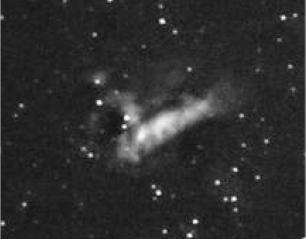LCAS Observer Challenge - August
Dave Wagner

The July/August Challenge list focuses on many of the summer objects in Sagittarius. This constellation is crowded with many interesting objects, such as M17 (Jul/Aug - Year 2) pictured above. This emission nebula and open cluster (flipped in this picture, to help show the 'Swan' shape) is a region of star formation, though the stars are obscured by the nebula. The nebula, with a total mass of about 800 suns, is estimated to be at a distance of more than 5.000 light years, the bright central area spanning about 15 light years, with the dimmer gaseous cloud extending out to 40 light years. It is said to be bright enough to be viewed by naked eye under favorable conditions. Use of an OIII or UHC filter will enhance the details. This object rates a high '5' with several of our club members.
On the non-Messier side of the list is NGC6826, or the "Blinking Planetary". Located in 2200 light years away in the constellation Cygnus, this planetary nebula is visible from our area most of the year, dipping low to the horizon in the winter months. Unlike many PN's, you can see the faint white dwarf star that formed the nebula when the star, as a red giant, ejected its outer shell. Such is the expected fate of our sun as well. The object gets its name because the nebula appears to wink on an off as you look at the central star or use averted vision.
Make sure to catch these two objects, along with other challenge objects before many of them disappear below the horizon in September, though they will all be back again next year for your viewing pleasure.
September/October Lists
The LCAS Observer Challenge (non-Messier) list has been expanded from its original July/August block to fill in the remainder of the year. I am still interested in adding any favorites YOU may have to the list at any time. Be sure to get the latest copy from the web site, Yahoo site. It will be marked "Issue A". September and October shifts our night view a bit, as Sagittarius, Scorpius and the center of our Milky Way dip below the horizon, replaced by Cetus, Sculptor, Eridanus and even Orion starts to climb back into the sky. You can still get some of the July/August block items you may have missed, as quite a few of the objects remain visible due to their position, still high in the night sky.
In the September/October block we again have a mix of 'basic' and 'challenge' objects. The Messier list for this block is made up of some fine open and globular clusters and one planetary nebula, the 'Ring' nebula. Among the non-Messier list we have a few member submissions in the form of the 'ET Cluster' (NGC457) and the 'Silver Coin' (NGC253), a bright edge on galaxy.
Clear skies and enjoy!





